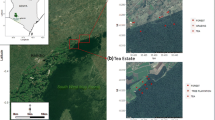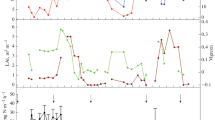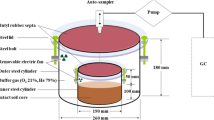ABSTRACT
In a combined field and laboratory study in the southwest of Burkina Faso, we quantified soil-atmosphere N2O and NO exchange. N2O emissions were measured during two field campaigns throughout the growing seasons 2005 and 2006 at five different experimental sites, that is, a natural savanna site and four agricultural sites planted with sorghum (n = 2), cotton and peanut. The agricultural fields were not irrigated and not fertilized. Although N2O exchange mostly fluctuated between −2 and 8 μg N2O–N m−2 h−1, peak N2O emissions of 10–35 μg N2O–N m−2 h−1 during the second half of June 2005, and up to 150 μg N2O–N m−2 h−1 at the onset of the rainy season 2006, were observed at the native savanna site, whereas the effect of the first rain event on N2O emissions at the crop sites was low or even not detectable. Additionally, a fertilizer experiment was conducted at a sorghum field that was divided into three plots receiving different amounts of N fertilizer (plot A: 140 kg N ha−1; plot B: 52.5 kg N ha−1; plot C: control). During the first 3 weeks after fertilization, only a minor increase in N2O emissions at the two fertilized plots was detected. After 24 days, however, N2O emission rates increased exponentially at plot A up to a mean of 80 μg N2O–N m−2 h−1, whereas daily mean values at plot B reached only 19 μg N2O–N m−2 h−1, whereas N2O flux rates at plot C remained unchanged. The calculated annual N2O emission of the nature reserve site amounted to 0.52 kg N2O–N ha−1 a−1 in 2005 and to 0.67 kg N2O–N ha−1 a−1 in 2006, whereas the calculated average annual N2O release of the crop sites was only 0.19 kg N2O–N ha−1 a−1 and 0.20 kg N2O–N ha−1 a−1 in 2005 and 2006, respectively. In a laboratory study, potential N2O and NO formation under different soil moisture regimes were determined. Single wetting of dry soil to medium soil water content with subsequent drying caused the highest increase in N2O and NO emissions with maximum fluxes occurring 1 day after wetting. The stimulating effect lasted for 3–4 days. A weaker stimulation of N2O and NO fluxes was detected during daily wetting of soil to medium water content, whereas no significant stimulating effect of single or daily wetting to high soil water content (>67% WHCmax) was observed. This study demonstrates that the impact of land-use change in West African savanna on N trace gas emissions is smaller—with the caveat that there could have been potentially higher N2O and NO emissions during the initial conversion—than the effect of timing and distribution of rainfall and of the likely increase in nitrogen fertilization in the future.









Similar content being viewed by others
REFERENCES
Andersson M, Kjøller A, Struwe S 2003. Soil emissions of nitrous oxide in fire-prone African savannas. J Geophys Res 108:4630–9
Anderson IC, Levine JS 1987. Simultaneous field measurements of biogenic emissions of nitric oxide and nitrous oxide. J Geophys Res 92:965–76
Anderson IC, Levine JS, Poth MA, Riggan PJ 1988. Enhanced biogenic emissions of nitric oxide and nitrous oxide following surface biomass burning. J Geophys Res 93:3893–8
Bouwman AF, Boumans LJM, Batjes NH 2002. Emissions of N2O and NO from fertilized fields: summary of available measurement data. Glob Biogeochem Cycles 16:1058
Breuer L, Papen H, Butterbach-Bahl K 2000. N2O emission from tropical forest soils of Australia. J Geophys Res 105:26353–67
Butterbach-Bahl K, Gasche R, Breuer L, Papen H 1997. Fluxes of NO and N2O from temperate forest soils: impact of forest type, N deposition and of liming on the NO and N2O emissions. Nutr Cycles Agroecosys 48:79–90
Cardenas L, Rondon A, Johansson C, Sanhueza E 1993. Effects of soil moisture, temperature, and inorganic nitrogen on nitric oxide emissions from acidic tropical savanna soils. J Geophys Res 98:14783–90
Castaldi S, De Pascale RA, Grace J, Nikonova N, Montes R, San José J 2004. Nitrous oxide and methane fluxes from soils of the Orinoco savanna under different land uses. Glob Change Biol 10:1947–60
Castaldi S, Ermice A, Strumia S 2006. Fluxes of N2O and CH4 from soils of savannas and seasonally-dry ecosystems. J Biogeogr 33:401–15
Chapuis-Lardy L, Wrage N, Metay A, Chotte JL, Bernoux M 2007. Soils, a sink for N2O? A review. Glob Change Biol 13:1–17
Cicerone RJ, Shetter JD, Stedman DH, Kelly TJ, Liu SC. 1978. Atmospheric N2O: measurements to determine its sources, sinks, and variations. J Geophys Res 83:3042–50.
Clayton H, Arah JRM, Smith KA 1994. Measurement of nitrous oxide emissions from fertilized grassland using closed chambers. J Geophys Res 99:16599–607
Cole L 1986. The savannas: biogeography und geobotany. London: Academic Press, p 438
Davidson EA 1991. Fluxes of nitrous oxide and nitric oxide from terrestrial ecosystems. In: Rogers JE, Whitman WB, Eds. Microbial production and consumption of greenhouse gases: methane, nitrogen oxides, and halomethanes. Washington: American Society for Microbiology. pp 219–35
Davidson EA 1993. Soil water content and the ratio of nitrous oxide and nitric oxide emitted from soil. In: Oremland RS, Ed. Biogeochemistry of global change: radiatively active trace gases. London: Chapman and Hall. pp 369–86
Davidson EA, Matson PA, Vitousek PM, Riley R, Dunkin K, Garciá-Méndez G, Maass JM 1993. Processes regulating soil emissions of NO and N2O in a seasonally dry tropical forest. Ecology 74:130–9
Davidson EA, Verchot LV 2000. Testing the hole-in-the-pipe model of nitric and nitrous oxide emissions from soils using the TRAGNET database. Glob Biogeochem Cycles 14:1035–43
De Carvalho AM, Bustamante MMD, Kozovits AR, de Miranda LN, Vivaldi LJ, de Sousa DM 2006. Nitrogen oxides emission related to urea broadcasting fertilization under conventional and no-tillage systems. Pesquisa Agropecuaria Brasileira 41:679–85
Dick J, Skiba U, Munro R, Deans D 2006. Effect of N-fixing and non-N-fixing trees and crops on NO and N2O emissions from Senegalese soils. J Biogeogr 33:416–23
Ding W, Yagi K, Akiyama H, Sudo S, Nishimura S 2007. Time-lagged induction of N2O emission and its trade-off with NO emission from a nitrogen fertilized Andisol. Soil Sci Plant Nutr 53:362–72
Dobbie KE, McTaggert IP, Smith KA 1999. Nitrous oxide emissions from intensive agricultural systems: variations between crops and seasons, key driving variables, and mean emission factors. J Geophys Res 104:26891–9
Donoso L, Santana R, Sanhueza E 1993. Seasonal variation in N2O fluxes at a tropical savanna site: soil consumption of N2O during the dry season. Geophys Res Lett 20:1379–82
Erickson H, Keller M, Davidson EA 2001. Nitrogen oxide fluxes and nitrogen cycling during postagricultural succession and forest fertilization in the humid tropics. Ecosystems 4:67–84
Firestone MK, Davidson EA 1989. Microbiological basis of NO and N2O production and consumption in soil. In: Andreae MO, Schimel DS, Eds. Exchange of trace gases between terrestrial ecosystems and the atmosphere. Chichester: John Wiley and Sons Ltd. pp 7–21
Flessa H, Dorsch P, Beese F 1995. Seasonal variation of N2O and CH4 fluxes in differently managed arable soils in southern Germany. J Geophys Res 100:23115–23
Galbally IE, Johansson C 1989. A model relating laboratory measurements of rates of nitric oxide production and field measurements of nitric oxide emission from soils. J Geophys Res 94:6473–80
Garrido F, Henault C, Gaillard H, Perez S, Germon JC 2002. N2O an NO emissions by agricultural soils with low hydraulic potentials. Soil Biol Biochem 34:559–75
Glaser B, Lehmann J, Führböter M, Solomon D, Zech W 2001. Carbon and nitrogen mineralization in cultivated and natural savanna soils of Northern Tanzania. Biol Fert Soils 33:301–9
Hergoualc’h K, Skiba U, Harmand M, Oliver R 2007. Processes responsible for the nitrous oxide emission from a Costa Rican Andosol under a coffee agroforestry plantation. Biol Fert Soils 43:787–95
Ingwersen J, Butterbach-Bahl K, Gasche R, Richter O, Papen H 1999. Barometric process separation (BaPS): new method to quantify gross nitrification, denitrification, and N2O sources in soil. Soil Sci Soc Am J 63:117–28
IPCC 2001. Climate change 2001: the scientific basis. Contribution of Working Group I to the Third Assessment Report of the Intergovernmental Panel on Climate Change. In: Houghton JT, Ding Y, Griggs DJ, Noguer M, van der Linden PJ, Dai X, Maskell K, Johnson CA, Eds. Cambridge: Cambridge University Press
IPCC 2006. N2O emissions from managed soils, and CO2 emissions from lime and urea application. In: Eggleston HS, Buendia L, Miwa K, Ngara T, Tanabe K, Eds. 2006 IPCC Guidelines for National Greenhouse Gas Inventories, vol. 4, Agriculture, Forestry and Other Land Uses. Japan: IGES. pp 11.1–11.54
IPCC 2007. Climate change 2007: the physical science basis. Contribution of Working Group I to the Fourth Assessment Report of the Intergovernmental Panel on Climate Change. In: Solomon S, Qin D, Manning M, Chen Z, Marquis M, Averyt KB, Tignor M, Miller HL, Eds. Cambridge: Cambridge University Press
Johansson C, Sanhueza E 1988. Emission of NO from savanna soils during the rainy season. J Geophys Res 93:14193–8
Keller M, Weitz AM, Bryan B, Rivera MM, Silver WL. 2000. Soil-atmosphere nitrogen oxide fluxes: effects of root disturbance. J Geophys Res 105:17693–8.
Levine JS, Cofer WS III, Cahoon DRJ, Winstead EL, Sebacher DI, Sebacher S, Scholes MC, Parsons DAB, Scholes RJ 1996. Biogenic soil emissions of nitric oxide (NO) and nitrous oxide (N2O) from savannas in South Africa: the impact of wetting and burning. J Geophys Res 101:23689–97
Levine JS, Cofer WS III, Sebacher S, Boston PJ 1988. The effects of fire on biogenic soil emissions of nitric oxide and nitrous oxide. Glob Biogeochem Cycles 2:445–9
Ludwig J, Meixner FX, Vogel B, Förstner J 2001. Soil-air exchange of nitric oxide: an overview of processes, environmental factors, and modeling studies. Biogeochemistry 52:225–57
Mathieu O, Hénault C, Lévêque J, Baujard E, Milloux MJ, Andreux F 2006. Quantifying the contribution of nitrification and denitrification to the nitrous oxide flux using 15N tracers. Environ Pollut 144:933–40
Müller C, Abbasi MK, Kammann C, Clough TJ, Sherlock RR, Stevens RJ, Jäger HJ 2004. Soil respiratory quotient determined via barometric process separation combined with nitrogen-15 labeling. Soil Sci Soc Am J 68:1610–5
Rees RM, Wuta M, Furley PA, Li C 2006. Nitrous oxide fluxes from savanna (miombo) woodlands in Zimbabwe. J Biogeogr 33:424–37
Rosenkranz P, Brüggemann N, Papen H, Xu Z, Horváth L, Butterbach-Bahl K 2006. Soil N and C trace gas fluxes and microbial soil N turnover in a sessile oak (Quercus petraea (Matt.) Liebl.) forest in Hungary. Plant Soil 286:301–22
Rudolph J, Rothfuss F, Conrad R 1996. Flux between soil and atmosphere, vertical concentration profiles in soil, and turnover of nitric oxide: 1. Measurements on a model soil core. J Atmos Chem 23:253–73
Russow R, Sich I, Neue HU 2000. The formation of the trace gases NO and N2O in soils by the coupled processes of nitrification and denitrification: results of kinetic 15N tracer investigations. Chemosphere Glob Change Sci 2:359–66
Ryden JC. 1981. N2O exchange between a grassland soil and the atmosphere. Nature 292:235–7.
Sanhueza E, Hao W, Scharffe D, Donoso L, Crutzen PJ 1990. N2O and NO emissions from soils of the northern part of the Guayana Shield, Venezuela. J Geophys Res 95:22481–8
Scholes RJ, Hall DO 1996. The carbon budget of tropical savannas, woodlands and grasslands. In: Breymeyer AI, Hall DO, Melillo JM, Agren GI, Eds. Global change: effects on coniferous forests and grasslands, SCOPE, vol. 56. Chichester: Wiley. pp 69–100
Scholes MC, Martin R, Scholes RJ, Parsons D, Winstead E 1997. NO and N2O emissions from savanna soils following the first simulated rains of the season. Nutr Cycl Agroecosys 48:115–22
Skopp J, Jawson MD Doran JW 1990. Steady-state aerobic microbial activity as a function of soil water content. Soil Sci Soc Am J 54:1619–25
Varella RF, Bustamante MMC, Pinto AS, Kisselle KW, Santos RV, Burke RA, Zepp RG, Viana LT 2004. Soil fluxes of CO2, CO, NO, And N2O from an old pasture and from native Savanna in Brazil. Ecol Appl 14:221–31
Venterea RT 2007. Nitrite-driven nitrous oxide production under aerobic soil conditions: kinetics and biochemical controls. Glob Change Biol 13:1798–809
Wilcke W, Lilienfein J 2005. Nutrient leaching in oxisols under native and managed vegetation in Brazil. Soil Sci Soc Am J 69:1152–61
Wrage N, van Groenigen JW, Oenema O, Baggs EM 2005. A novel dual-isotope labelling method for distinguishing between soil sources of N2O. Rapid Commun Mass Spectrom 19:3298–306
ACKNOWLEDGMENTS
Funding for this research work was provided by the Helmholtz Association of German Research Centers (Virtual Institute, VH-VI-001). The authors thank Georg Willibald, Ralf Kiese, Christian Werner, Boris Matejek, and Michael Dannenmann for scientific advice, data handling procedures and technical assistance, as well as Dominik Schmengler of the Dreyer Foundation for infrastructural support during the field campaigns, and Gildas Houénagnon Boko for collecting climate data.
Author information
Authors and Affiliations
Corresponding author
Rights and permissions
About this article
Cite this article
Brümmer, C., Brüggemann, N., Butterbach-Bahl, K. et al. Soil-Atmosphere Exchange of N2O and NO in Near-Natural Savanna and Agricultural Land in Burkina Faso (W. Africa). Ecosystems 11, 582–600 (2008). https://doi.org/10.1007/s10021-008-9144-1
Received:
Revised:
Accepted:
Published:
Issue Date:
DOI: https://doi.org/10.1007/s10021-008-9144-1




